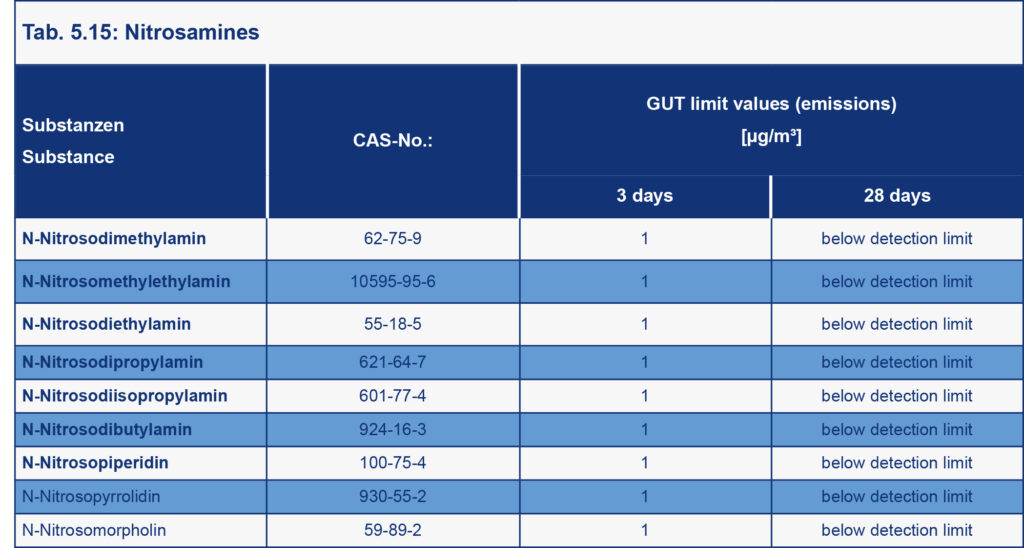Grenzwerte und Verwendungsverbote
für einzelne Substanzen oder Substanzklassen im Rahmen der Prüfung von Teppichböden
Erfahren Sie auf dieser Seite mehr über die Grenzwerte und Verwendungsverbote von bestimmten Substanzen und Substanzklassen bei der Herstellung von textilen Bodenbelägen.
Sicherheit für den Verbraucher & Umweltschutz
Mit Hilfe klassischer chemischer Analysenverfahren sowie modernen Schnelltests, werden sowohl die Rohstoffe als auch der textile Bodenbelag selbst auf eine Vielzahl von Schadstoffen überprüft. Hierzu gehören Schwermetalle, Weichmacher, Biozide und Pestizide, die klassischen POPs (Persistant Organic Pollutants) sowie die REACH SVHCs.
Für die nachfolgend aufgelisteten Substanzen oder Substanzgruppen sind im GUT-System entweder Grenzwerte festgelegt oder Verwendungsverbote definiert.
Diese Maßnahmen wurden nicht nur mit Blick auf die Sicherheit des Verbrauchers getroffen, sondern auch um negative Einflüsse auf die Umwelt zu vermeiden. Die nachfolgenden Tabellen informieren über die einzelnen Schadstoffklassen und die zugeordneten Grenzwerte.
Farbstoffe und Färbereihilfsmittel (1 von 7)
Weitere Informationen zu allergenisierenden und cancerogene Farbstoffe:
Die Verwendung von Farbstoffen die als Allergenisierend oder cancerogen eingestuft wurden ist im Rahmen des GUT-Systems verboten.
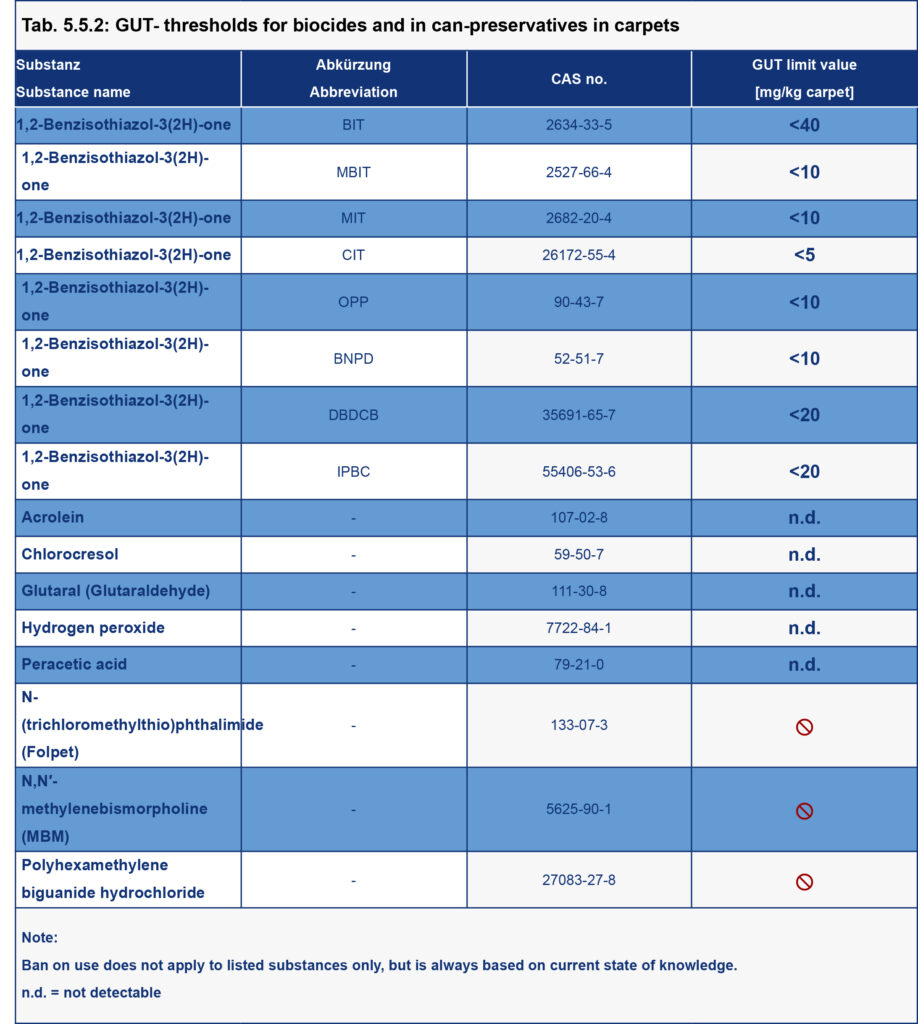
Weitere Informationen zu den AZO-Farbstoffen:
Von den etwa 4.000 im Colour-Index aufgelisteten Farbstoffen sind etwa die Hälfte Azo- farbstoffe. Sie stellen somit die mit Abstand bedeutendste Farbstoffgruppe dar. Nicht wenige dieser Azofarbstoffe werden auf der Basis von krebserzeugenden Aminen herge- stellt, einige davon sind auch heute noch kommerziell erhältlich. Nach Aufnahme in den Körper können diese Azoverbindungen im Stoffwechsel reduktiv gespalten werden und die entsprechenden aromatischen Amine bilden, aus denen sie synthetisiert wurden. Zur Azospaltung befähigt sind Darmbakterien, aber auch die Leber enthält entsprechende En- zyme.
Die Verwendung der gelisteten Azofarbstoffe ist im Rahmen des GUT-Systems verboten.
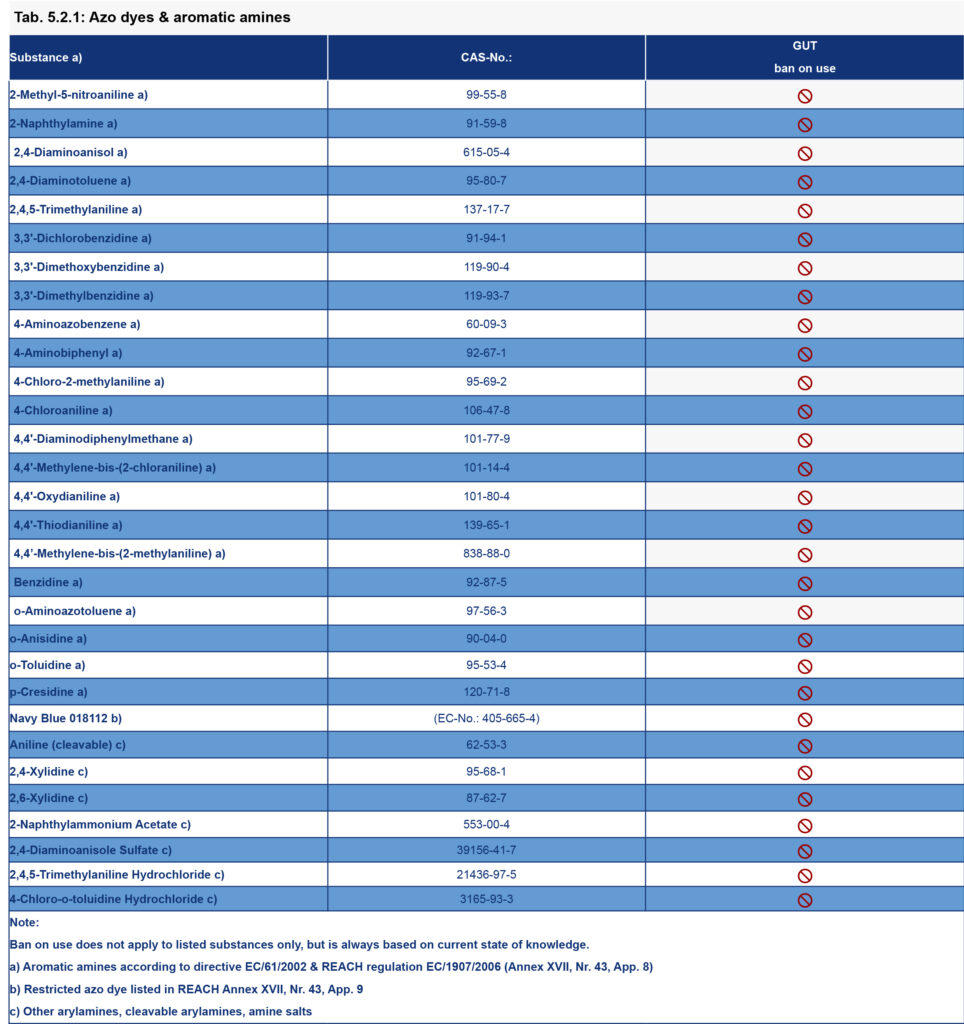
Weitere Informationen zu Färbebeschleunigern:
Färbebeschleuniger (Carrier) sind organische Lösemittel, die beim Färben von Chemiefasern (Polyester, Acetat, Polyacrylnitril, Polyamid) mit Dispersionsfarbstoffen als Hilfsmittel einge- setzt werden. Sie bewirken eine schnellere Durchdringung der Fasern mit den Farbstoffen. Für Polyester (Polyethylenterephthalat, PET) als die bei Bekleidung mengenmäßig bedeutsamste Chemiefaser, hat die Färbung mit Dispersionsfarbstoffen eine besonders große Be- deutung. Diese wird entweder mit Hilfe von Carriern bei 95 °C oder unter Hochtemperatur- Bedingungen (HT) bei 130 °C durchgeführt. Bei der HT-Färbung sind Carrier im Prinzip nicht notwendig, jedoch werden sie auch dort in geringeren Mengen zum Erzielen einer gleichmä- ßigen Färbung als Egalisiercarrier verwendet. Auch zum Färben von Wolle-Polyester- Mischgeweben werden Carrier eingesetzt, da durch den Wollanteil die Temperatur auf 110- 115 °C begrenzt werden muss.
Nach erfolgter Färbung liegen die Restgehalte je nach Substanz und Färbesystem zunächst zwischen 5 und 37 g/kg Faser (0,5-3,7 %). Die Carriergehalte können durch unterschiedliche Nachbehandlungen reduziert werden, eine völlige Entfernung ist kaum möglich. Wenn die Färbung nach dem Stand der Technik durchgeführt wurde, liegt die Konzentration an Carriern unter 0,2 %, anderenfalls sind Gehalte bis zu 2,7 % auf dem Textil nicht auszuschließen.
Die Verwendung der gelisteten Färbebeschleunigern ist im Rahmen des GUT-Systems nicht erlaubt.

Schwermetalle und Weichmacher (2 von 7)
Weitere Informationen zu Schwermetallen:
Schwermetalle kommen in verschiedenen Formen natürlich vor. Sie spielen eine wichtige Rolle im pflanzlichen, tierischen oder menschlichen Organismus. Ein Mangel an essentiellen Schwermetallen kann durchaus gesundheitliche Beeinträchtigungen zur Folge haben. Umgekehrt können aber auch bei vielen Schwermetallen, wie z.B. bei Blei oder Arsen, schwere Vergiftungen auftreten, wenn zuviel davon aufgenommen wird. Um den Eintrag bestimmter Schwermetalle in die Umwelt zu vermeiden sind im GUT-System verschiedene Grenzwerte definiert worden. Diese beziehen sich entweder auf den Gehalt eines Schwermetalls oder aber auf die Freisetzung des Schwermetalls unter bestimmten Bedingungen. Die nachfolgende Tabelle gibt einen Überblick über die derzeit gültigen Grenzwerte.

Weitere Informationen zu Weichmachern:
Weichmacher sind Stoffe die spröden Materialien zugesetzt werden, um sie weich, biegsam oder dehnbar zu machen, damit sie einfacher zu bearbeiten sind oder bestimmte Gebrauchseigenschaften erreichen. Sie sind in großen Mengen in Kunststoffen, Lacken, Anstrich- und Beschichtungsmitteln, Dichtungsmassen, Kautschuk- und Gummi-Artikeln sowie in Klebstoffen enthalten.
Auch bei der Textilveredlung spielen weichmachende Substanzen eine Rolle, um die Griffigkeit und Geschmeidigkeit zu verbessern. Die Weichmacher können aus dem Material austreten.
Bedeutende Quellen für Weichmacher in der Innenraumluft und im Hausstaub sind Bauprodukte wie Fußbodenbeläge, Handläufe, Tür- und Fensterdichtungen, sofern sie Hart- oder Weich-PVC enthalten, Elektrokabel, manche Möbel, die unter Verwendung phthalathaltiger Kleber oder Farben hergestellt worden sind und Einrichtungsgegenstände, Badewannen- und Duscheinlagen sowie Duschvorhänge.
Insbesondere Phthalat-basierte Weichmacher sind aufgrund ihrer hormonellen Wirkung bedenklich.
Die Verwendung der nachfolgend aufgelisteten Substanzen ist im Rahmen des GUT-Systems nicht erlaubt.
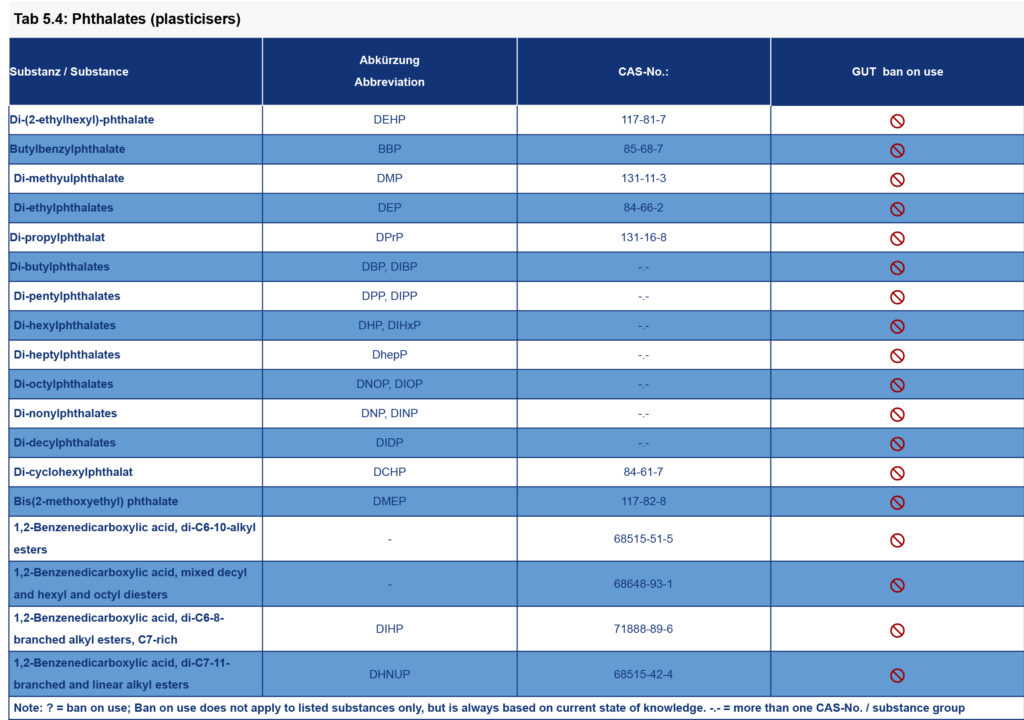
Biozide Ausrüstungen, Topfkonservierer und Pestizide (3 von 7)
Weitere Information zu biozid wirkenden Substanzen:
In der europäischen Gesetzgebung werden Biozide definiert als chemische Substanzen oder Mikroorganismen, die dazu bestimmt sind, schädliche Organismen mit chemischen oder biologischen Mitteln zu zerstören, abzuschrecken, unschädlich zu machen, ihre Wirkung zu verhindern oder sie in anderer Weise zu bekämpfen.
Die Verordnung zielt darauf ab, die Funktionsweise des Marktes für Biozidprodukte in der EU zu verbessern und gleichzeitig ein hohes Schutzniveau für Mensch und Umwelt zu gewährleisten.
Innerhalb des GUT-Systems gelten folgende Grundsätze für den Einsatz von Bioziden:
- Biozide müssen für die Verwendung in der EU zugelassen sein als
- Produkt Typ 6: Konservierungsmittel für Produkte während der Lagerung
- Produkt Typ 11: Konservierungsmittel für Flüssigkühl- und Verarbeitungssysteme
- Produkt Typ 12: Schleimbekämpfungsmittel
- für diese zugelassenen Biozide gelten GUT-Gehalte und/oder Elutionsschwellenwerte für den endgültigen Teppichboden (siehe Tabelle)
- die aktive Verwendung oder der Zusatz von Bioziden zu textilen Bodenbelägen als Appretur oder Oberflächenbehandlung ist verboten
Eine Ausnahme bildet die Behandlung von Wollteppichen mit Permethrin (siehe Wollausrüstung 5.10)
Folglich ist eine aktive biozide, biostatische oder fungizide Ausrüstung nicht zulässig. Bietet ein Hersteller textile Bodenbeläge mit und ohne biozide Ausrüstung an, gilt die GUT-Lizenz nur für das Produkt ohne biozide Ausrüstung.
Anmerkung:
Der Einsatz von Bioziden, insbesondere bei der Herstellung und Lagerung von Rohstoffen, kann nicht ganz ausgeschlossen werden, da die Konservierung von Rohstoffen oder die Instandhaltung von Produktionsanlagen notwendig ist, um eine biologische Kontamination des Endproduktes zu vermeiden. Dies kann zu Rückständen im Teppichboden führen. Es ist das Ziel, den Restgehalt dieser Konservierungsmittel auf ein Niveau zu reduzieren, das für den Anwender keine Schäden verursacht. Daher werden in diesem Fall nur Biozide akzeptiert, die in der Biozid-Produkte-Verordnung (BPR, Verordnung (EU) 528/2012) zugelassen und gelistet sind.
Biozide, von denen bekannt ist oder vermutet wird, dass sie krebserzeugend, erbgutverändernd oder fortpflanzungsgefährdend sind, sind innerhalb des GUT-Systems nicht erlaubt, selbst wenn sie für die Verwendung in der EU zugelassen sind.
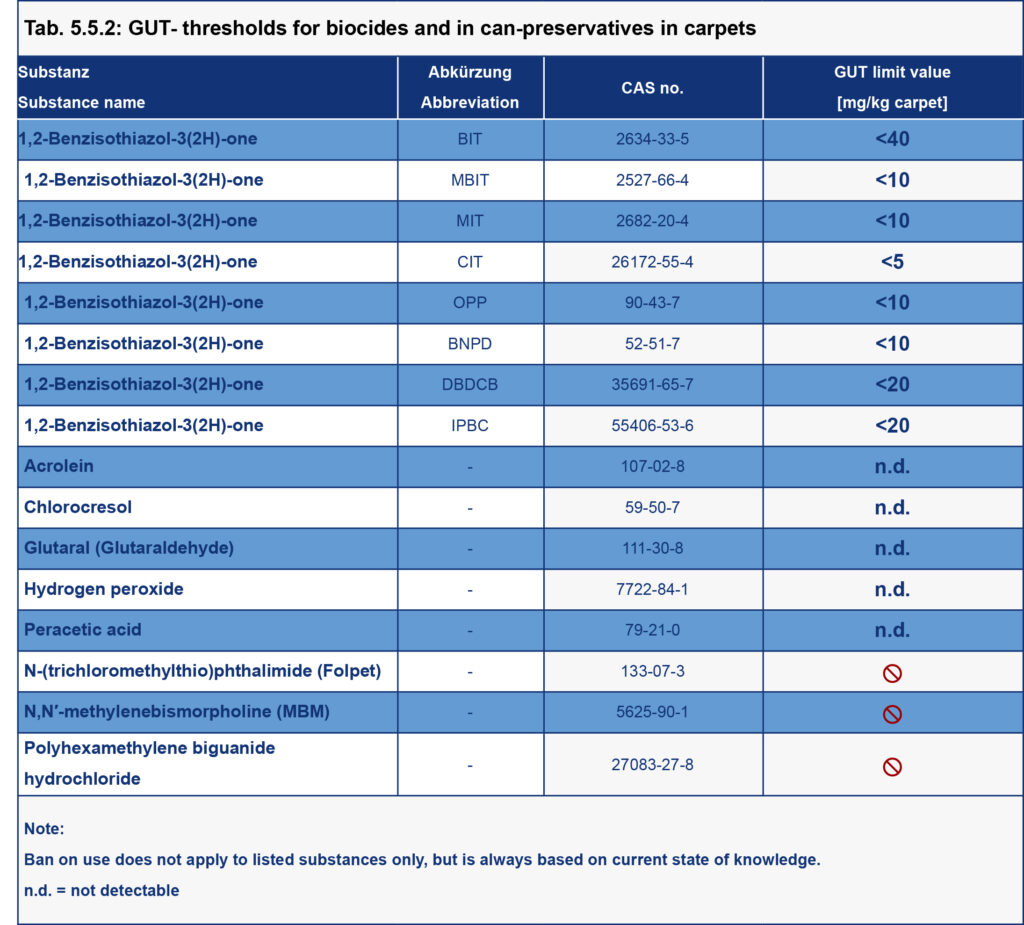
5.5.2.Grenzwerte & Verwendungsverbote_ Substanzen in Teppichböden_biozide
Weitere Informationen zu Chlorphenolen:
Chlorphenole gehören zur Gruppe der Organochlorpestizide. Chlorphenole werden als Holzschutzmittel, Herbizid, Fungizid und zum Bleichen von Zellstoff in der Papierherstellung eingesetzt. Wegen seiner giftigen Wirkung ist PCP bereits seit lager Zeit verboten.
Innenraumrelevante Vorkommen
- Mit Holzschutzmittel behandelte Holzoberflächen, z. B. Balken, Böden, Fenster, Dachstühle
- Behandelte und imprägnierte Textilien aus Leder, z. B. Sitzgarnituren, Schuhe, Lederbekleidung
- Behandelte Naturmaterialien, z. B. Wolle, Kokosfasern
- Farben, Lacke
Die Verwendung der nachfolgend aufgeführten Substanzen ist im Rahmen des GUT-Systems verboten.
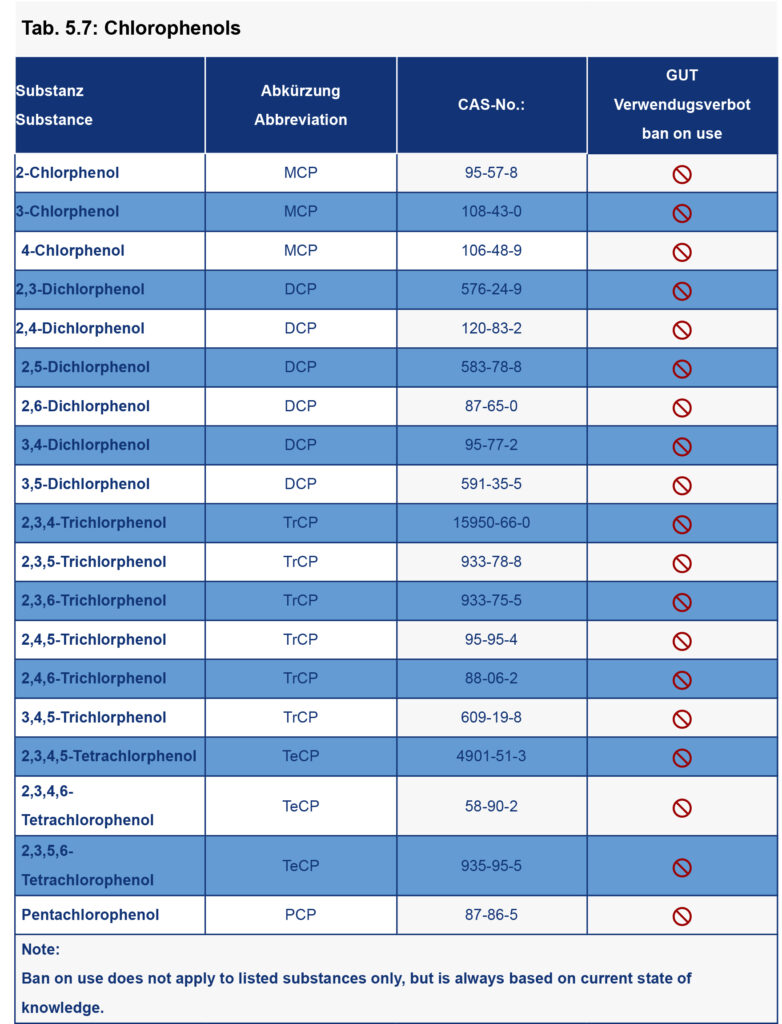
Weitere Informationen zu Pestiziden:
Als Pestizid nach heutigem Verständnis werden sämtliche Pflanzenschutzmittel und sonstige Mittel zur Schädlingsbekämpfung aufgefasst. Die EU-Richtlinie 2009/128/EG enthält eine Begriffsbestimmung für „Pestizid“, nach der sowohl Pflanzenschutzmittel im Sinne der Verordnung (EG) Nr. 1107/2009 (Pflanzenschutzmittelverordnung) als auch Biozid-Produkte im Sinne der Richtlinie 98/8/EG über das Inverkehrbringen von Biozid-Produkten darunter fallen.
Wenn in der öffentlichen Diskussion von „Pestizid-Rückständen“ die Rede ist, liegt der Fokus meist auf der Belastung von Lebensmitteln mit Pflanzenschutzmittel-Rückständen.
Die Verwendung der nachfolgend aufgeführten Substanzen ist im Rahmen des GUT-Systems verboten.
Weitere Informationen zu Zinn-organischen Verbindungen:
Zinnorganische Verbindungen können als Biozide in Holzschutzmitteln, oder auch als Additive und Katalysatoren eingesetzt werden. Ende der 1990er Jahre wurden weltweit jährlich ca. 40.000 Tonnen produziert.
- 76 % wurden als Stabilisatoren für PVC
- 10 % als Biozide in Unterwasser-Anstrichen
- 8 % als Fungizide und
- 5 % als Katalysatoren bei der Herstellung von Polyurethan-Schäumen und Silikonen eingesetzt.
Die Verwendung ist in der EU weitgehend verboten.
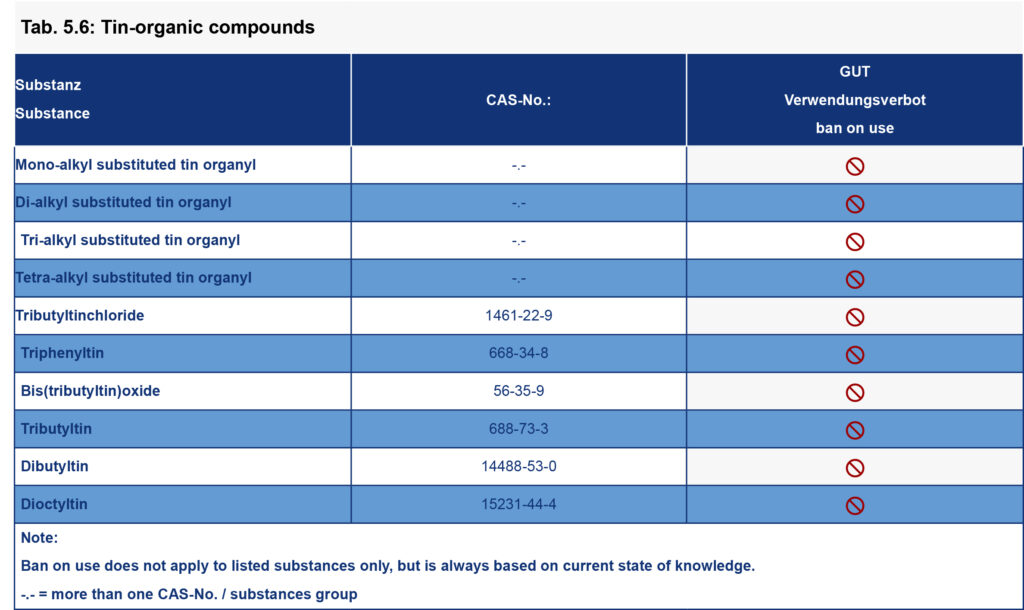
Formaldehyd und Ausrüstungen zum Wollschutz (4 von 7)
Weitere Informationen zu Formaldehyd:
Es gibt eine Vielzahl von Produkten, die Formaldehyd enthalten und die Formaldehyd an die Raumluft abgeben können. Trotz Verbesserungen bei den Produkten in den letzten Jahrzehnten gelten Holzwerkstoffe, Bodenbeläge, Möbel, und bestimmte Dämmstoffe (z.B. Harnstoff (Urea)-Formaldehyd-Ortschäume [UF-Ortschäume]) weiterhin als Hauptquellen. In Tabakrauch ist Formaldehyd in vergleichsweise großer Menge enthalten und selbst brennende Kerzen können eine Eintragsquelle für Formaldehyd in die Raumluft darstellen. Formaldehyd kann darüber hinaus in Desinfektionsmitteln, Kosmetikartikeln und Textilien enthalten sein.
Die Verwendung von Formaldehyd und Formaldehyd-freisetzenden Chemikalien ist im Rahmen des GUT-Systems verboten.
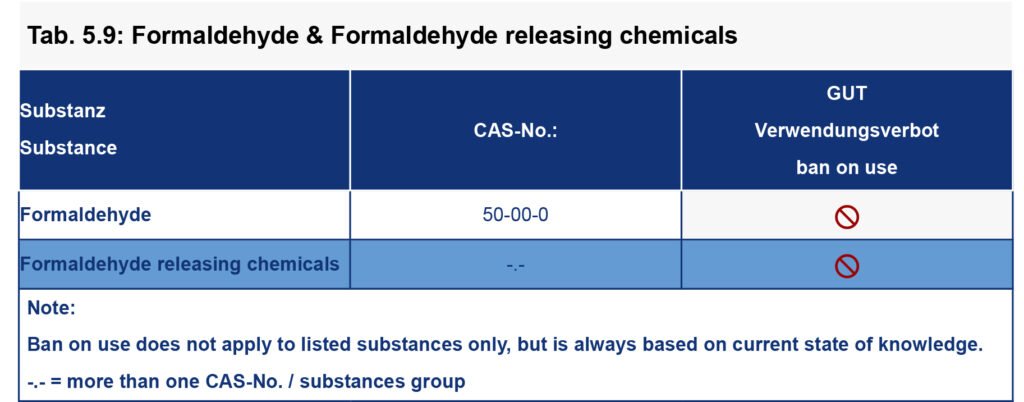
Wolle ist eine Faser auf Keratinbasis und wird daher von verschiedensten Insekten (-larven) als Nahrungsquelle genutzt. Die bekanntesten sind Mottenlarven.
Zum Schutz der Wollfasern werden daher verschiedenste Chemikalien eingesetzt.
Im Rahmen des GUT-Systems ist für die Schutzausrüstung von Wollfasern nur der Wirkstoff Permethrin zugelassen.
Es gibt insgesamt 3 Schutzklassen, die sich nach der aufgebrachten Menge und damit nach dem Schutzniveau unterscheiden. Der maximal erlaubte Permethrin-Gehalt beträgt 210 mg/kg Wolle
- Klasse 1: Kein Schutz := die Wollfasern sind nicht mit Permethrin behandelt
- Klasse 2: Normaler Schutz := die Wollfasern sind mit maximal 150 mg Permethrin pro kg Wollfasern behandelt
- Klasse 3: Hoher Schutz := die Wollfasern sind mit max 210 mg Permethrin pro Kg Wollfasern behandelt.
Zur Ausrüstung dürfen nur solche Verfahren verwendet werden, die eine feste Ausrüstung der Faser erlauben. Sprühapplikationen sind nicht erlaubt.
Flammschutzmittel und PAK (5 von 7)
Weitere Informationen zu Flammschutzmitteln:
Bei Flammschutzmitteln handelt es sich um eine Vielzahl verschiedener organischer und anorganischer Chemikalien. Ihr Einsatz wird jeweils auf das spezifische Produkt, dessen Materialzusammensetzung und Verwendungszweck abgestimmt. Produkte, in denen Flammschutzmittel eingesetzt werden, sind beispielsweise die Gehäuse von Elektro- und Elektronikgeräten, Leiterplatten, Kabel, Teppichrückenbeschichtungen, spezielle Textilien, Dämmstoffe und Montageschäume.
Die organischen Flammschutzmittel bestehen vor allem aus bromierten Verbindungen, halogenhaltigen beziehungsweise halogenfreien phosphororganischen Verbindungen oder Chlorparaffinen. Als anorganische Flammschutzmittel werden in erster Linie Aluminiumtrihydroxid (ATH), Magnesiumdihydroxid oder Antimontrioxid (als Synergist bromierter FSM) eingesetzt.
73% der im privaten Bereich eingesetzten Teppiche benötigen zur Einhaltung der deklarierten Brandsschutzklasse keine zusätzlichen Flammschutzmittel. In allen anderen Fällen wird ATH eingesetzt. Im öffentlichen Bereich, wo teilweise höhere Sicherheitsanforderungen gelten, sind etwa 54% der Teppiche mit Flammschutzmitteln ausgerüstet.
Im Rahmen des GUT-Systems sind die aufgelisteten Chemikalien nicht erlaubt.
Weitere Informationen zu polyaromatischen Kohlenwasserstoffen:
PAK-haltige Weichmacheröle sind preiswert und werden in vielen verschiedenen Konsumgütern eingesetzt. Außerdem wird oft auch Industrieruß genutzt um Kunststoffe und Gummi schwarz einzufärben.
Viele PAK haben krebserregende, erbgutverändernde und/oder fort- pflanzungsgefährdende Eigenschaften. Einige PAK sind gleichzeitig persistent, bioakkumulierend und giftig (toxisch) für Menschen und andere Organismen.
PAK entstehen bei der unvollständigen Verbrennung von organischem Material wie Holz, Kohle oder Öl. Allgemein gilt: Je niedriger die Temperatur des Feuers und je weniger Sauerstoff zur Verfügung steht, desto unvollständiger verbrennen die Materialien und desto mehr PAK entstehen. Ein großer Teil der PAK gelangt bereits durch Naturprozesse, wie Waldbrände oder Vulkanausbrüche, die nicht durch den Menschen beeinflussbar sind in die Atmosphäre.
Auch die von Menschen verursachten PAK-Emissionen stammen hauptsächlich aus Verbrennungsprozessen: aus Kleinfeuerungsanlagen, industriellen Prozessen, Feuerstellen oder Tabakrauch.
Für textile Bodenbeläge gelten im Rahmen des GUT-Systems die folgenden Grenzwerte.
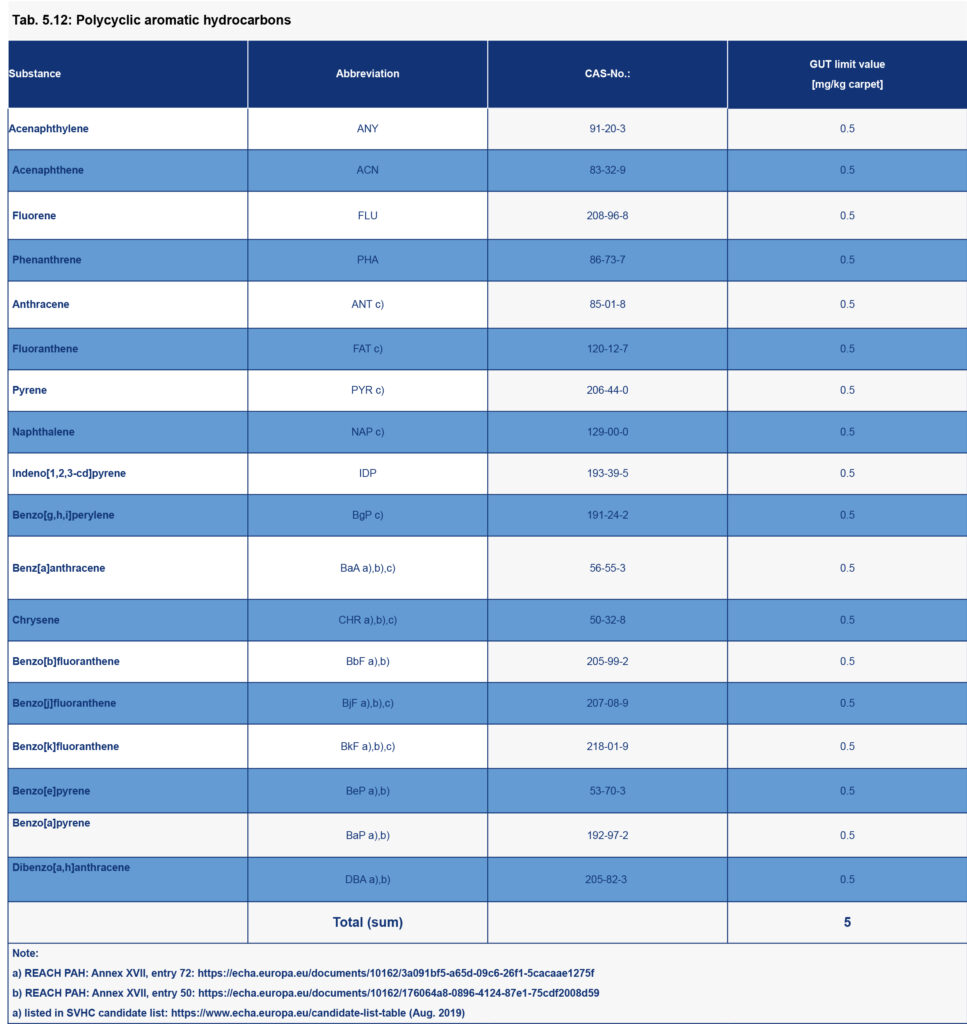
Perfluorierte Substanzen (6 von 7)
Weitere Informationen zu Perfluor Verbindungen:
Allen diesen Stoffen ist gemeinsam, dass die für organische Verbindungen typische Kohlenstoff-Wasserstoff-Bindung vollständig oder zumindest teilweise durch eine Kohlenstoff-Fluor-Bindung ersetzt wurde. Diese Bindung ist äußerst stabil und verleiht den Stoffen eine hohe chemische und thermische Beständigkeit.
„Perfluoroctansulfonsäure (PFOS) und Perfluoroctansäure (PFOA) sind Industriechemikalien. PFOS wurde bis zum Jahr 2006 etwa als Ausgangsmaterial zur Herstellung von schmutz-, fett- und wasserabweisenden Oberflächenbehandlungen von Teppichen, Polsterungen und Verpackungen aus Pappe und Papier und in Feuerlöschmitteln verwendet.
Seit 2006 ist der Gebrauch von PFOS in der EU stark eingeschränkt, sodass die Substanz nur noch in wenigen Spezialanwendungen erlaubt ist. PFOA basierte Verbindungen hingegen dürfen noch bis ins Jahr 2020 verwendet werden. Die Industrie benutzt sie, um Antihaftbeschichtungen für Bratpfannen herzustellen und um Kleidung wasser-, öl- und schmutzabweisend zu machen.
Ab dem Jahr 2020 dürfen PFOA, deren Salze und Vorläuferverbindungen weder hergestellt noch in den Verkehr gebracht werden. Beide Substanzen sind chemisch sehr stabil, lösen sich sowohl in Wasser als auch Fett und verteilen sich daher leicht in der Umwelt. Von dort aus gelangen sie in die Nahrungskette.
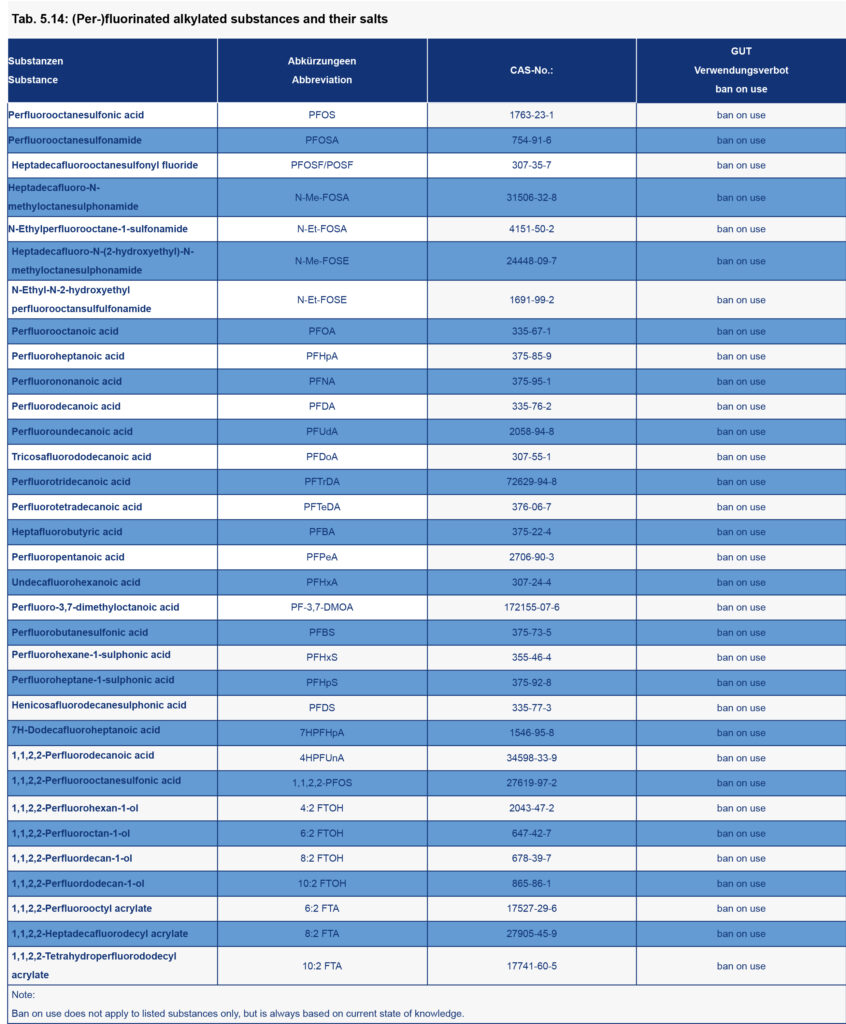
Anorganische Fasern, Nitrosamine und andere Substanzen (7 von 7)
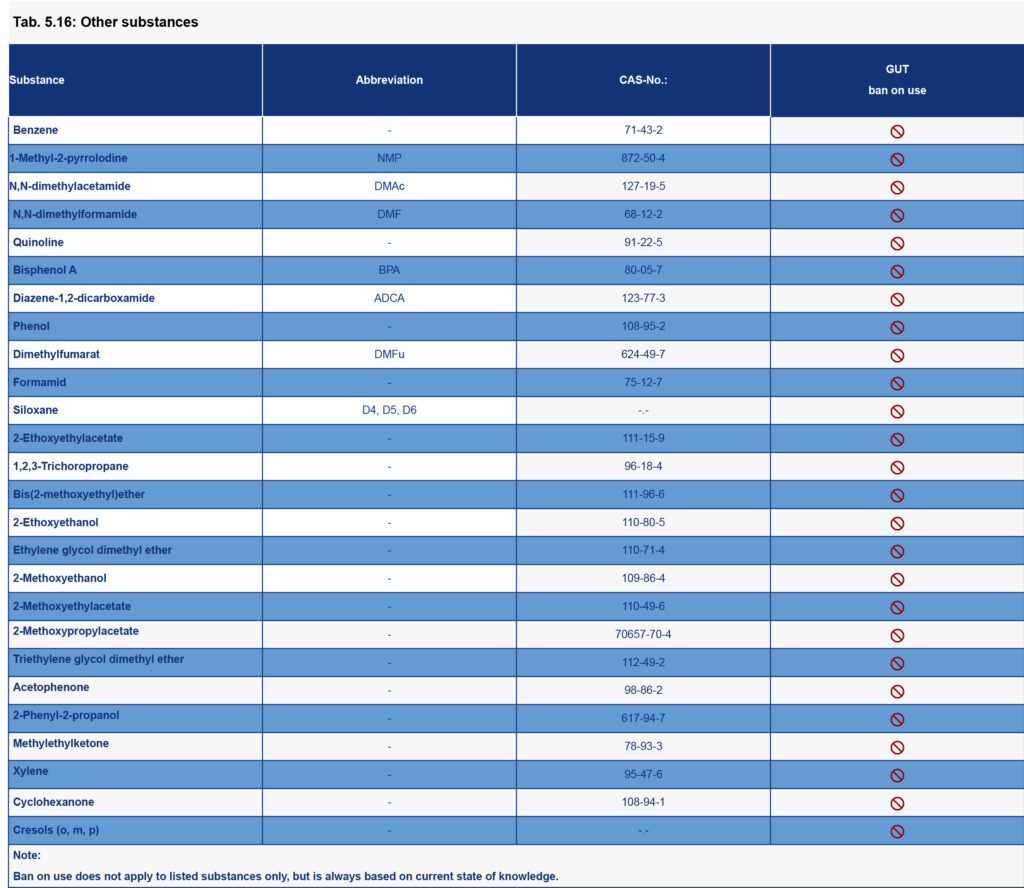
Weitere Informationen zu anorganischen Fasern:
Asbest ist eine Sammelbegriff für verschiedene natürlich vorkommende, faserförmige kristallisierte Silikat-Minerale (anorganische Fasern) die nach ihrer Aufbereitung technisch verwendbare Fasern unterschiedlicher Länge ergeben.
Da diese Fasern leicht brechen und die Bruchstücke aufgrund des Längen-zu-Durchmesser-Verhältnisses leicht lungengängig sind, können die eingeatmeten Fasern Lungenkrebs verursachen.
Die Verwendung von Asbestfasern ist im GUT-System verboten.
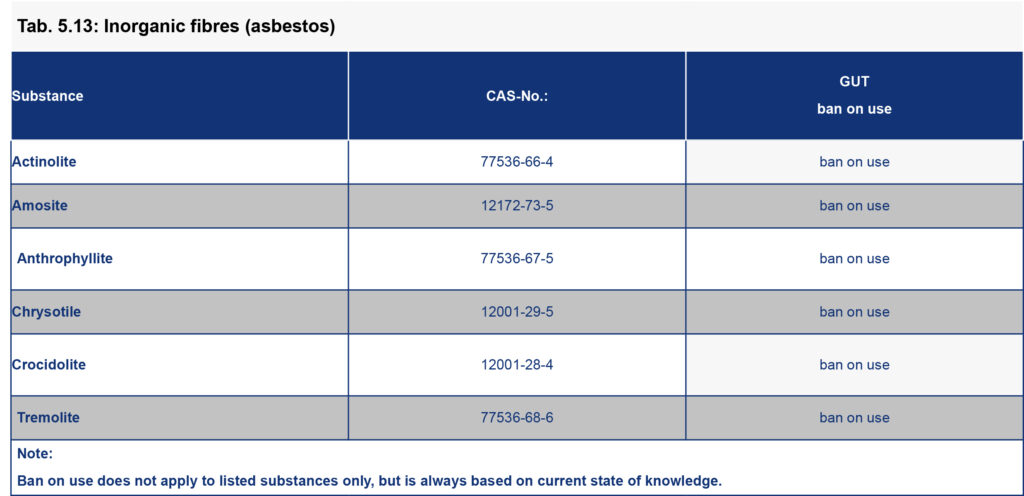
Weitere Informationen zu Nitrosamine:
Bei der Herstellung von vulkanisierten Schäumen auf SBR-Basis werden sogenannte Vulkanisationsbeschleuniger eingesetzt. Unter bestimmten Bedingungen können diese Substanzen Nitrosamine bilden.
Im Rahmen des GUT-Systems ist der Einsatz von Zn-Diethyldithiocarbamat als Vulkanisationsbeschleuniger verboten.
Für Nitrosamine gelten die folgenden Emissionsgrenzwerte:
